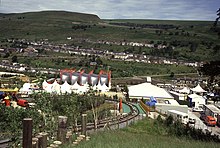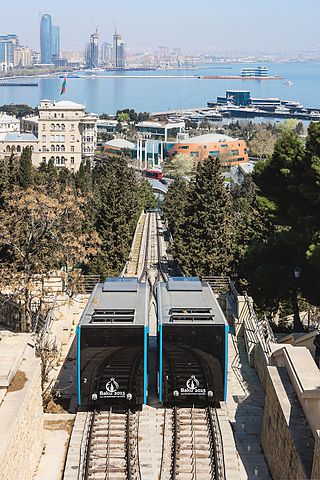
A funicular is a type of cable railway system that connects points along a railway track laid on a steep slope. The system is characterized by two counterbalanced carriages permanently attached to opposite ends of a haulage cable, which is looped over a pulley at the upper end of the track. The result of such a configuration is that the two carriages move synchronously: as one ascends, the other descends at an equal speed. This feature distinguishes funiculars from inclined elevators, which have a single car that is hauled uphill.

Ebbw Vale is a town at the head of the valley formed by the Ebbw Fawr tributary of the Ebbw River in Wales. It is the largest town and the administrative centre of Blaenau Gwent county borough. The Ebbw Vale and Brynmawr conurbation has a population of roughly 33,000. It has direct access to the dualled A465 Heads of the Valleys trunk road and borders the Brecon Beacons National Park.

The Peak Tram is a funicular railway in Hong Kong, which carries both tourists and residents to the upper levels of Hong Kong Island. Running from Garden Road Admiralty to Victoria Peak via the Mid-Levels, it provides the most direct route and offers good views over the harbour and skyscrapers of Hong Kong. Operated since 1888, it was the first funicular railway in Asia.

The Dresden Suspension Railway is a suspended funicular located in Dresden, Germany, and connects the districts of Loschwitz and Oberloschwitz. It is one of the oldest suspension railways, having entered service on 6 May 1901, the same year the Wuppertal Schwebebahn entered service. Like the Wuppertal railway, the system was designed by Eugen Langen. The line is 274 metres (899 ft) long and is supported on 33 pillars.

The Fløibanen is a funicular railway in the Norwegian city of Bergen. It connects the city centre with the mountain of Fløyen, with its mountain walks and magnificent views of the city. It is one of Bergen's major tourist attractions and one of Norway's most visited attractions. The line is 847 m (2,779 ft) long, covers a height difference of 302 m (991 ft), and carries over one million passengers a year. The line is owned by Fløibanen AS, a company with a number of shareholders, the biggest being the municipality of Bergen.

The Great Orme Tramway is a cable-hauled 3 ft 6 in gauge tramway in Llandudno in north Wales. Open seasonally from late March to late October, it takes over 200,000 passengers each year from Llandudno Victoria Station to just below the summit of the Great Orme headland. From 1932 onwards it was known as the Great Orme Railway, reverting to its original name in 1977.

The Ebbw Valley Railway is a branch line of the South Wales Main Line in South Wales. Transport for Wales Rail provides an hourly passenger service each way between Ebbw Vale Town and Cardiff Central, and an hourly service each way between Ebbw Vale Town and Newport.

The Wellington Cable Car is a funicular railway in Wellington, New Zealand, between Lambton Quay, the main shopping street, and Kelburn, a suburb in the hills commanding views overlooking the central city, rising 120 m (394 ft) over a length of 609 m (1,998 ft).
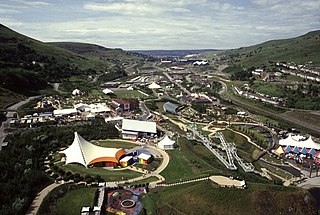
The Ebbw Vale Garden Festival of Wales attracted over two million visitors to Ebbw Vale in South Wales.
The Guindais Funicular is a funicular railway in the civil parish of Cedofeita, Santo Ildefonso, Sé, Miragaia, São Nicolau e Vitória, Portuguese municipality of Porto. It connects the district of Batalha, situated uphill to the north, with Ribeira, by the riverside to the south. The station in Batalha is by the terminus of the vintage tram line 22 and within walking distance of São Bento station for metro and railway connections. The station in Ribeira is by the Dom Luís I Bridge. It runs alongside the remains of the Fernandine Walls.
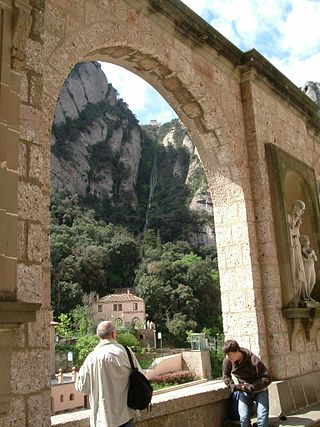
The Sant Joan Funicular is a funicular railway at Montserrat, near Barcelona in Catalonia, Spain. The line connects the monastery, and the upper terminus of the Montserrat Rack Railway, with sacred sites, walking trails and viewpoints higher up the mountain. With a maximum gradient of 65 %, it is the steepest funicular in Spain.

The Santa Cova Funicular is a funicular railway at Montserrat, near Barcelona in Catalonia, Spain. The line descends from the monastery, and the upper terminus of the Montserrat Rack Railway, on a continuous curve to a lower station that gives access, via a path, to Santa Cova, a shrine lower down the mountain.

The Montjuïc Funicular is a funicular railway in the city of Barcelona, in Catalonia, Spain. The railway mainly runs through a tunnel and connects the Barcelona Metro's Paral·lel station with the hill of Montjuïc and the various sporting facilities and other attractions there.
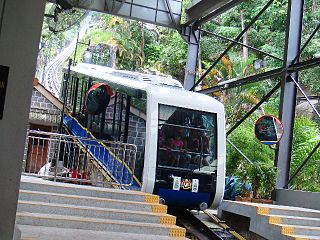
The Penang Hill Railway is a one-section funicular railway which climbs the Penang Hill from Air Itam, on the outskirts of the city of George Town in the Malaysian state of Penang. The railway first opened in 1923 as a two-section railway, but was overhauled in 2010 into a one-section system. It is a single-track railway with a passing loop, and it passes through a tunnel which is the steepest in the world. The total journey time can take between five and twenty minutes. The funicular train coach travels directly from the lower station to the top, but may stop at other intermediate stations upon request.
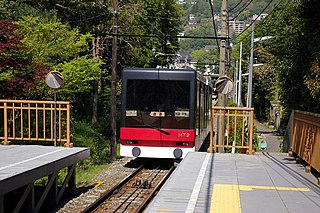
The Hakone Tozan Cable Car, officially the Cable Line, is a funicular railway in the town of Hakone, Kanagawa Prefecture, Japan. It is operated by Odakyu Hakone, a Odakyu Group company who also operates the Hakone Tozan Train.

The Trieste–Opicina tramway is an unusual hybrid tramway and funicular railway in the city of Trieste, Italy. It links Piazza Oberdan, on the northern edge of the city centre, with the village of Villa Opicina in the hills above.

The Augustusburg Cable Railway is a funicular railway in Saxony, Germany. It connects the station of Erdmannsdorf-Augustusburg, in the village of Erdmannsdorf and on the Annaberg-Buchholz–Flöha railway, with the town of Augustusburg on the hill above.

The Dolderbahn is a 1.3 km (0.81 mi) long rack railway in the Swiss city of Zürich. The line is in Zürich's Hottingen and Fluntern suburbs on the south slope of the Adlisberg mountain. The lower terminus of the line is at Römerhof, some 1.5 km (0.93 mi) from the city centre, where it connects with lines 3 and 8 of the Zürich tramway. The upper terminus at Bergstation Dolderbahn is adjacent to the Dolder Grand Hotel and the Dolder recreation area. Two intermediate stations, at Titlisstrasse and Waldhaus Dolder, are also served.

The Lugano Città–Stazione funicular, Funicolare Lugano Città–Stazione, or Sassellina, is a funicular railway in the city of Lugano in the Swiss canton of Ticino. The line's upper station is located within the main railway station of Lugano, and the lower station is on Piazza Cioccaro in the historic city centre below. It is one of the busiest funicular lines in Switzerland, carrying 2.4 million passengers in 2007.

The Swansea Constitution Hill Incline Tramway operated a cable funicular tramway service on Constitution Hill in Swansea between 1898 and 1901.
